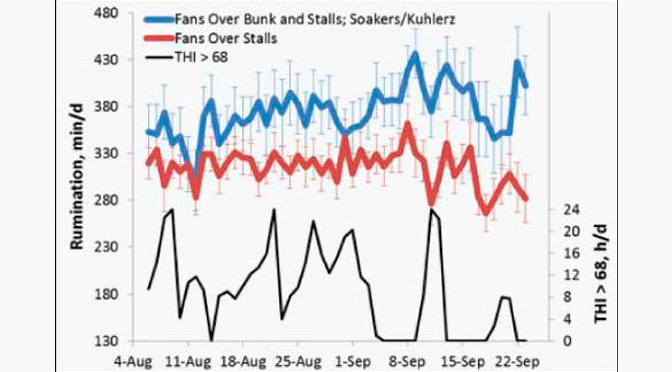Heat stress is a problem throughout the country, even for us here in northern New York. Not only do we have a direct milk loss due to heat stress, but the hot temperatures and the associated behaviors have a negative effect on our cows’ health. With minimal heat abatement it’s been estimated that there is a $600/cow/year loss in hot regions such as Florida and Texas, and $72/cow/year loss in Wisconsin. Heat stress occurs everywhere and the costs add up, so heat stress abatement is critical to having healthy productive cows.

Heat stress doesn’t just come at a certain temperature, but from a combination of temperature and humidity. The temperature humidity index (THI) is a combination of environmental temperature and relative humidity, and is the index used to determine the threshold of when our cows experience heat stress. Cows experience heat stress once the THI reaches a level above their thermal neutral zone. For years it was thought that cows experience heat stress above a THI of 72, but more recently it has been found that high producing cows (>77 lbs of milk/day) experience heat stress at a THI of 68. As our cows are producing more they have a greater metabolic heat output, which makes them more susceptible heat stress at a lower THI.
Heat stress is associated with decreased eating and rumination, as well as increased respiration rate and standing time. Due to those altered behaviors heat stress can often induce rumen acidosis. Specifically this induced acidotic condition can be attributed to changes in respiration rate and feeding behavior. Increased respiration rate leads to a decreased amount of CO2 in the blood, to keep the HCO3: CO2 blood ratio correct kidneys excrete excess HCO3 resulting in less to buffer the rumen. The cow will not only lose buffer due to respiration changes, but also due to less saliva entering and buffering the rumen. Decreased rumination results in less saliva being produced, and heat stress also results in increased drooling, causing saliva that is produced to be lost rather than entering the rumen to act as a buffer. As well as losing buffers, when a cow is heat stressed she is more likely to slug feed with one or two large meals throughout the day, often with more sorting during those meals. All of these effects accumulate and can induce ruminal acidosis, even when the ration would not normally result in acidotic conditions. Increased standing can also have a long term effect on lameness, with the peak of lameness occurring about two months after the peak heat stress period.
Investing in heat abatement for your cows is the best way to help mitigate these negative effects. Heat stress effects and costs vary by region; in 2001 St. Pierre estimated that in New York state there is a 2:1 return on investment of a heat abatement system. In the late summer of 2013 Miner Institute collected preliminary data on using a combination of different heat stress abatement systems (sprinklers or soakers with fans) over a period of time compared to using minimal heat abatement (fans only). The rumination data shows just how important heat abatement is and how it can help to mitigate the negative effects of heat stress. In the graph, the blue line represents cows that had optimal heat abatement, while the red line represents those cows with minimal heat abatement. The black line represents the hours of each day that were over the heat stress threshold of our high producing cows, a THI of 68.
You can see that except for a few occurrences the cows with optimal heat abatement had a higher average rumination time per day than cows with minimal heat abatement. This increased rumination helps add more of a buffer into the rumen which lessens the chance of rumen acidosis. Although both groups may still have altered eating behavior such as slug feeding, the fact that the cows with optimal heat abatement are ruminating more should mitigate some of those negative effects.
Overall, heat stress is a very costly problem in all areas of the country. Heat abatement is a relatively easy way to keep cows healthy and happy, and will reduce your economic losses due to the summer heat.
Autor: Sarah Williams, do Instituto Mineiro
Fonte: dairyherd


